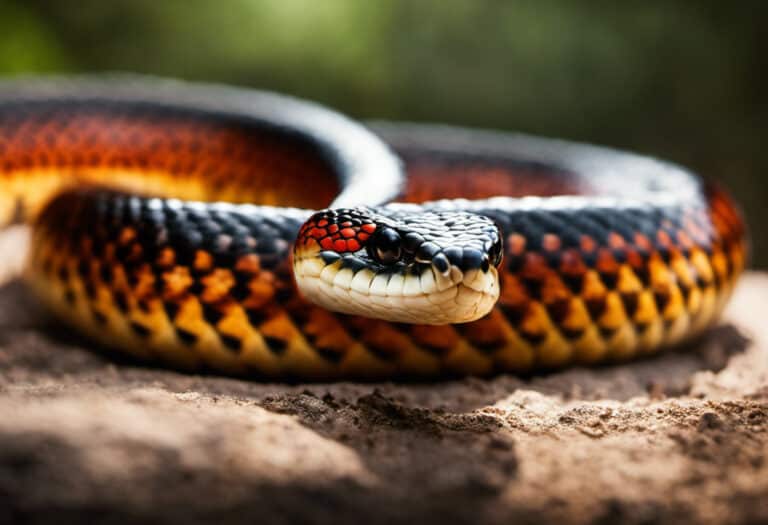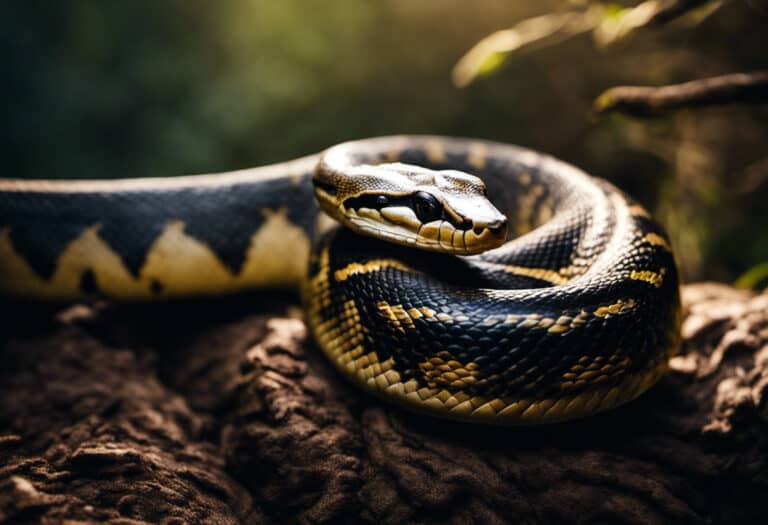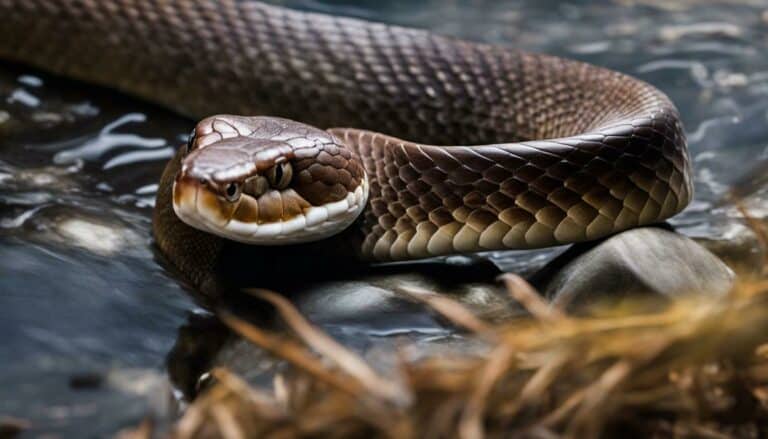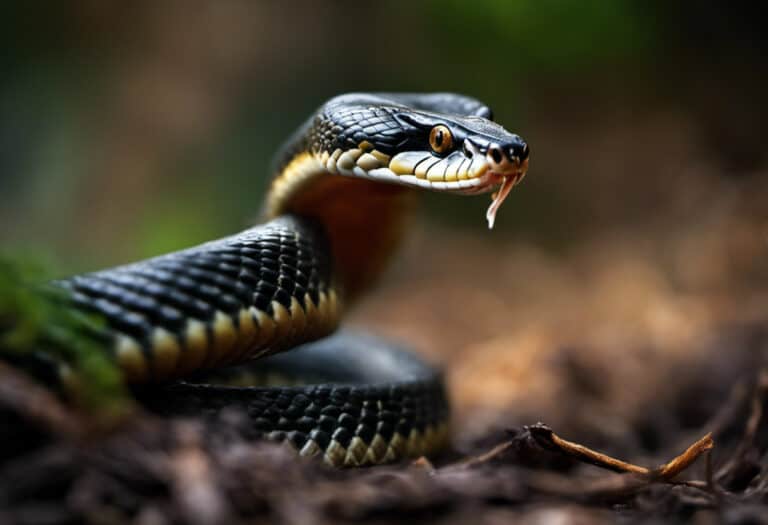Do Rat Snakes Have Teeth?
Do you ever wonder if rat snakes have teeth? Well, you’ve come to the right place to find out! In this article, we’ll explore the dental wonders of rat snakes.
Did you know that rat snakes have approximately 100 teeth? These small yet sharp incisors allow them to bite, grip, and hold onto their prey. However, their teeth aren’t sharp enough to break the skin.
Join us as we uncover fascinating facts about the dental anatomy of rat snakes and delve into their behavior, diet, and more!
Key Takeaways
- Rat snakes have small, sharp teeth but not venomous fangs.
- Rat snakes use their teeth for biting, gripping, and holding onto prey.
- Rat snakes have 100 small, sharp teeth that they use for biting and gripping prey.
- The teeth of rat snakes are sharp enough to leave a mark if bitten but not sharp enough to break the skin.
The Dental Anatomy of Rat Snakes
Rat snakes, like other black snakes, have a set of small, sharp teeth that they use for biting and gripping their prey.
Understanding rat snakes’ dental health is crucial to comprehending their hunting abilities. These teeth play a vital role in capturing prey effectively. With approximately 100 small, sharp teeth, rat snakes possess the necessary tools to hold onto their victims tightly.
Although not venomous, their teeth can leave a mark if bitten. The teeth face backward, aiding in the snake’s ability to grip its prey securely. Unlike some other snakes, rat snakes don’t have upper teeth. Their teeth are small but sharp, hidden in the gums, making them less noticeable.
Rat snakes rely on their long, sharp teeth to kill and consume their prey.
Understanding Rat Snakes’ Biting Behavior
Understanding rat snakes’ biting behavior is crucial for handling them safely.
Rat snakes are generally non-aggressive and will only bite if they feel threatened or cornered.
When they do bite, their small, sharp teeth can cause pain and minor injuries, but they aren’t venomous.
Rat Snakes’ Biting Behavior
When a rat snake bites, it can cause pain and swelling, but it isn’t typically aggressive towards humans. Rat snakes, like other black snakes, have small, sharp teeth that they use for biting, gripping, and holding onto their prey.
These teeth are sharp enough to leave a mark if bitten but not sharp enough to break the skin. Unlike snakes with fangs, rat snakes don’t have long, large, venomous teeth at the front of their mouths.
Rat snakes are beneficial to humans as they help control rodent populations by eating rodents and other pests. They use climbing and hunting techniques, such as squeezing their prey with their body mass. Some common types of rat snakes include black racers, mud snakes, and black rat snakes.
Are Rat Snakes Aggressive
If you encounter a rat snake, you may find that they aren’t typically aggressive towards humans. Rat snakes are known for their non-aggressive behavior and are generally harmless. They don’t pose a threat unless provoked or cornered.
Instead of attacking, rat snakes usually resort to defensive behaviors when they feel threatened. They may coil their bodies, hiss loudly, and even strike if they feel their personal space is invaded. However, these defensive behaviors are more of a warning rather than an actual attempt to harm.
Rat snakes prefer to avoid confrontation and will often retreat if given the chance. Understanding rat snakes’ aggression patterns and defensive behavior can help you coexist peacefully with these beneficial reptiles, as they play an essential role in controlling rodent populations.
Rat Snakes’ Teeth Anatomy?
You’ll notice that rat snakes’ teeth are sharp and functional for catching and gripping prey. Their dental adaptations play a crucial role in their feeding strategies.
-
Rat snakes have numerous small, sharp teeth that they use for biting and gripping their prey. These teeth are sharp enough to leave a mark but not sharp enough to break the skin, making them relatively harmless to humans.
-
Unlike some other snake species, rat snakes don’t possess venomous fangs. Instead, their teeth are designed for biting and holding onto their prey, allowing them to subdue and consume small mammals like rodents and lizards.
-
Rat snakes’ teeth face backward, aiding in their ability to grip and maintain a firm hold on their prey.
-
Additionally, rat snakes’ teeth are hidden in their gums and not visibly noticeable, contributing to their stealthy hunting approach.
Understanding the dental adaptations and feeding strategies of rat snakes provides insight into their remarkable ability to secure food in their natural habitat.
A Comparison of Rat Snakes’ Teeth and Fangs
Rat snakes have small, sharp teeth that they use for biting and gripping prey, but they don’t have long fangs. When comparing the dental structures of rat snakes with venomous snakes, it’s important to note the evolutionary advantages of rat snakes’ teeth over fangs.
While fangs are long, large, sharp teeth with venom, rat snakes’ teeth are smaller and more functional. Rat snakes use their teeth to catch and hold onto prey, but they don’t rely on venom to immobilize or kill their prey. This gives them the freedom to hunt a wide variety of prey without the need for specialized venom.
The small size and functional nature of their teeth also allow rat snakes to bite without causing severe harm to humans, making them less of a threat and more likely to be tolerated in areas where they help control rodent populations.
Rat Snakes’ Diet and Prey
Rat snakes have a varied diet that primarily consists of small mammals, such as rodents and lizards. They’re skilled hunters, using their body mass to constrict and squeeze the life out of their prey.
Their ability to adapt their diet to different environments allows them to thrive in a wide range of habitats.
Prey Preferences of Rat Snakes
If you encounter a rat snake, it’s important to know that their prey preferences typically consist of small mammals and reptiles. These snakes are skilled hunters, using a combination of stalking, ambushing, and constriction techniques to capture their prey.
They’re highly adaptable and can be found in a variety of habitats, including forests, grasslands, and even urban areas. Rat snakes are excellent climbers, allowing them to access their preferred habitats and search for prey in trees and bushes.
They’ve a keen sense of smell and use their forked tongues to gather scent particles from the environment, helping them locate potential meals. With their agile bodies and powerful muscles, rat snakes are able to quickly subdue and constrict their prey, using their teeth to hold onto their catch.
Impact of Diet on Rat Snake Behavior
When their diet consists mostly of small mammals, rat snakes exhibit different behavior and hunting techniques. The impact of diet on rat snake growth is significant, as it influences their ability to capture and consume prey.
Rat snakes have a unique relationship between their teeth and prey size. They possess numerous small, sharp teeth that enable them to bite, grip, and hold onto their prey. These teeth are not venomous, but they are effective in subduing small mammals. The size of the prey also affects the growth of rat snakes.
Consuming larger prey allows for more efficient energy intake, leading to faster growth rates. Additionally, rat snakes adjust their hunting techniques based on the size of their prey. For smaller mammals, they employ quick strikes and constricting methods, while larger prey necessitates more strength and endurance.
Overall, the diet of rat snakes plays a crucial role in their growth and hunting behavior, highlighting the intricate relationship between teeth, prey size, and overall survival.
| Rat Snake Teeth | Prey Size |
|---|---|
| Numerous small teeth | Small mammals |
| Not venomous | Rodents |
| Used for biting | Lizards |
| Sharp and effective | Small prey |
The Importance of Rat Snakes’ Teeth
The teeth of rat snakes are essential for biting, gripping, and holding onto their prey. These teeth play a crucial role in the hunting behavior of rat snakes.
Here is why the dental hygiene of rat snakes is important and how they use their teeth in hunting:
-
Dental hygiene is vital for the overall health of rat snakes. Regular cleaning of their teeth helps prevent infections and ensures proper function during hunting.
-
Rat snakes use their sharp teeth to grab and hold onto their prey. The teeth are positioned to face backward, allowing them to maintain a firm grip.
-
The 100 small, sharp teeth of rat snakes aren’t venomous, but they’re efficient in capturing and subduing their prey.
-
Rat snakes don’t have upper teeth but rely on their lower teeth to deliver a powerful bite.
Understanding the importance of dental hygiene and the role of teeth in hunting helps us appreciate the freedom that rat snakes have in their natural habitats.
Common Types of Rat Snakes and Their Dental Features
You might be interested to know that mud snakes, black racers, and rat snakes are some common types of black snakes. Among these, rat snakes are known for their interesting dental adaptations.
Rat snakes, which belong to the rat snake species, possess sharp teeth that allow them to effectively capture and consume their prey. These teeth are small but sharp, enabling them to grip onto their prey securely. Unlike venomous snakes, rat snakes don’t have venomous fangs. Instead, they rely on their teeth for biting and holding onto their prey.
The dental arrangement of rat snakes varies among different species, but they all possess small, sharp teeth that are used for hunting and feeding.
Rat snakes play an important role in controlling rodent populations, making them beneficial to our environment.
Tips for Handling Rat Snakes’ Teeth Safely
If handling a rat snake, be cautious of their small, sharp dental adaptations. Rat snakes have dental anatomy that’s designed for biting and gripping their prey.
Here are some tips for handling rat snakes’ teeth safely:
- Approach the snake calmly and confidently, avoiding sudden movements.
- Use a snake hook or snake tongs to gently support the snake’s body and keep its head away from you.
- Avoid putting your hands near the snake’s mouth, as their teeth can leave marks if bitten.
- If you need to handle the snake, wear thick gloves to protect your hands from any potential bites.
Frequently Asked Questions
How Many Teeth Do Rat Snakes Have?
Rat snakes have a varying number of teeth, depending on the species. Their teeth are small, sharp, and used for biting and gripping prey. The structure of rat snakes’ teeth allows them to effectively catch and hold onto their food.
Are Rat Snake Teeth Sharp Enough to Break the Skin?
Yes, rat snakes have teeth, but they don’t have venomous bites. Their teeth are sharp enough to leave a mark if bitten, but not sharp enough to break the skin or cause infection.
Do Rat Snakes Have Fangs?
Yes, rat snakes have teeth but not venomous fangs. Their teeth are sharp and used for biting and gripping prey. Rat snakes are not venomous and their diet consists mostly of small mammals.
What Is the Purpose of Rat Snakes’ Teeth?
Rat snake teeth serve multiple functions, such as biting and gripping prey. These teeth are sharp but not venomous, allowing them to leave a mark if bitten without breaking the skin. The teeth face backward and are small in size.
Can Rat Snake Bites Cause Pain and Swelling to Humans?
Yes, rat snake bites can cause pain and swelling to humans. If bitten, clean the wound with soap and water, apply antibiotic ointment, and seek medical attention to prevent infection.
Conclusion
In conclusion, rat snakes’ teeth are a marvel of nature, allowing them to bite, grip, and hold onto their prey. These small but sharp teeth, numbering around 100, aren’t sharp enough to break the skin but can certainly leave a mark if bitten.
With their teeth facing backward and lacking upper teeth, rat snakes have adapted to their unique feeding habits. The dental wonders of these remarkable creatures continue to fascinate and amaze researchers, shedding light on the intricate world of snake anatomy.





